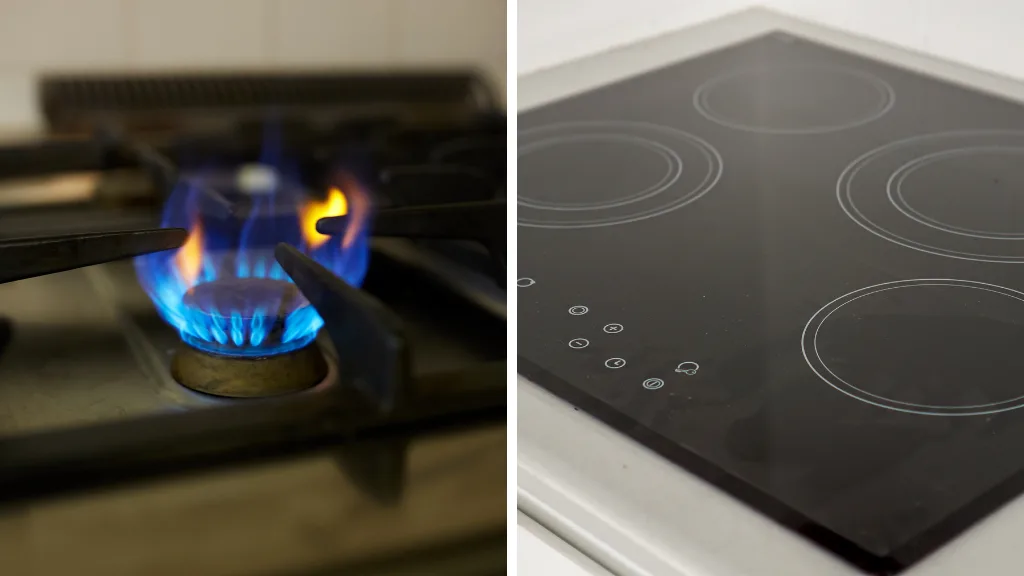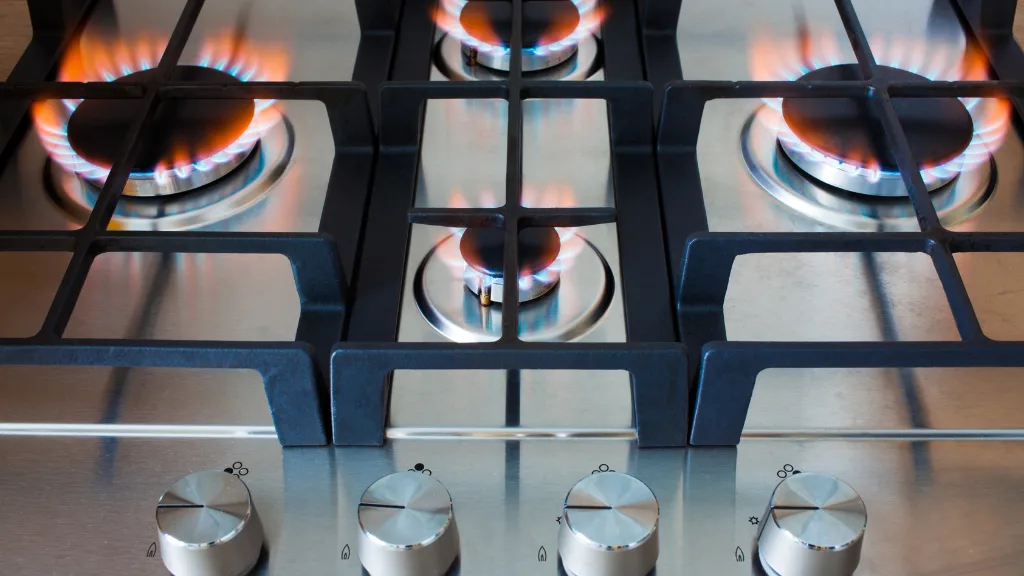
So you’re thinking about upgrading your kitchen appliances, and the two options that are most commonly used are gas stoves or electric stoves.
You may be wondering what the pros and cons of each stove type are, and this blog post here is to help guide you in choosing between these two cooking options.
Which one is better? Gas stoves are cheaper to buy, but electric stoves might be more efficient in the long run. We will go over some of the pros and cons for each stove type.
Gas Stoves
What Is a Gas Stove?
There are several types of stoves that use gas as the primary fuel source. These appliances include grills, ovens, cooktops, and ranges.
Gas stoves differ from electric or induction cooktops in that they have flames that heat pans instead of heating coils or magnets to generate heat. How does a gas stove work?
Types of Gas Stoves
As mentioned above, there are four types of stoves that use gas as the primary fuel source. These are grills, ovens, cooktops, and ranges.
Grilling – A grill is simply an open-flame cooking appliance that uses one or more gas burners to heat pans or grill food.
Ovens – An oven is an enclosed heating appliance that uses gas burners to heat the metal walls of the chamber and cook foods.
Cooktops – A cooktop is a flat surface with one or more burners where pots and pans can be placed to use the stove’s heat to simmer, boil, fry, or sauté the food.
Ranges – A range is a cooking appliance that has one or more ovens and at least one cooktop, but often also includes a griddle, broiler, steamer basket, and/or rotisserie.
How Does a Gas Stove Work?
Gas stoves work by burning gas, which is often mixed with air and ignited with a spark to produce heat. Some ovens and cooktops will use electric ignition instead of or in addition to a standing pilot light.
Gas is heavier than air, so it sinks to the floor and spreads across the room. This can be dangerous because it can potentially cause asphyxiation and fire.
For this reason, it is important to keep a working carbon monoxide detector near any gas appliance.
How Are Gas Stoves Different from Other Appliances?
Electric stoves and cooktops use coils or magnets to generate heat, whereas gas stoves have flames that heat pans. This means that a gas stove requires a gas line and a power source, whereas electric stoves only require electricity.
Safety Precautions for Using Gas Stoves
When using a gas stove, it is important to follow these safety precautions. Simply check that the burners are turned off when finished cooking.
Gas stoves in particular can be dangerous because they often have multiple open flames which could ignite if left unattended for several hours.
This type of fire can spread quickly and cause significant damage to your home.
Advantages and Disadvantages of Gas Stoves
A gas stove is extremely efficient when it comes to cooking. There are a couple more advantages that go with this type of stove.
Advantages
- The heat provided by the flame is easily adjustable for better cooking control, and since there are no flames licking up against your food like with an open fire or an electric stove, this type of fuel is much safer than the others mentioned above.
- Furthermore, most modern gas stoves come with an ignition system, making it easier to light the stove without having to deal with sparking mechanisms or dangerous open flames.
Disadvantages
- On the downside, gas stoves are more expensive than other kinds of stoves.
- Also, there are certain risks involved in using this type of fuel for your cooking needs. There have been cases where people have been burned by the open flames or explosions resulting from storing flammable objects nearby.
- Some gas stoves also produce an unpleasant smell, which can be nauseating at times.

Electric Stoves
What are Electric Stoves?
Electric stoves are a smooth-surface stove which is heated by electromagnetic radiation. In other words, these operate by making a current pass through a special wire called a heating element.
The electricity heats the element and that heat is transferred to the cooking area of the stove top by conduction.
Types of Electric Stoves
There are two types of electric stoves. Radiant and Induction.
Radiant – A radiant stove uses an element which is either coiled or serpentine (in the shape of a letter ‘S’) to heat the cooking surface.
Induction – On the other hand, an induction stove will use electromagnetic waves that pass through the air to generate heat directly in the pan.
How Does Electric Stoves Work?
When an electric stove is turned on, power flows to the heating element. The resistance of this element creates heat and the cook-top becomes hot.
Most of these elements are sealed in a metal sheath that is resistant to spills and high temperatures. A drip pan or other catch basin will also be placed under the element to catch accidents.
How Are Electric Stoves Different from Other Appliances?
Electric stoves are not different from other appliances. Except, of course, that they produce heat through a different method.
However it is important to note that the cooking surface is heated which means that the air around the stove top will also be hot.
Safety Precautions for Using Electric Stoves
Like any appliance, there are safety precautions one should take when using an electric stove. Below are a few of these precautions:
1) Turn the stove off when leaving the room or going to sleep. This is especially important in households with children and pets who could accidentally bump into it and get hurt.
2) Never use metal utensils on the cooking surface, this will scratch it and the scratches could cause the element to overheat or short circuit.
3) Keep an eye on pots and pans while cooking, do not let them boil dry because this could damage the stove top.
4) Always turn off the stove when cleaning, this will prevent accidents from occurring such as spilled water or cleaner getting into electrical parts of the stove.
Advantages and Disadvantages of Electric Stoves
Electric stoves have a few advantages but also a few disadvantages over other types of stove tops.
Advantages
- They are very easy to clean because the surface is smooth and flat, this makes food spillage less likely compared to standard coil stovetops.
- They are also very good at keeping heat low inside the kitchen, which means that household members will not feel as much heat.
- In addition, they are more energy-efficient than gas stoves and this is beneficial from an environmental perspective.
Disadvantages
- One of these is that the smooth surface makes it difficult to cook food that requires browning.
- Another disadvantage is the initial cost of these stoves, they are generally more expensive than other stovetops.
- Requires a special kind of cookware – using electric stoves means you need a special type of cookware. The cookware must be made of a ferromagnetic metal, such as cast iron; this means that aluminum and steel pans cannot be used.

How to Choose Between Gas Stoves and Electric Stoves
There are many benefits to using an electric stove rather than a gas stove. Electric stoves provide more even heating, instant ignition/turn-off, precise temperature control and easier clean-up after use.
However, it’s important to note that the type of cooking appliance can also be determined by the kind of cooking you do most often.
Over the past few years, there has been a significant increase in the number of gas and electric stoves. And with this rise is an important decision — which type of stove suits my household and kitchen best? Here’s what you need to know before making your purchase:
Points About Gas Versus Electric
- Gas stoves are more energy efficient and cost-effective to operate.
- However, electric ranges are safer as gas stoves can be hazardous.
- Electric stoves also allow you to control the heat output better with easily set temperature controls.
- On the other hand, using a gas stove allows for more cooking methods such as grilling or frying due to the higher heat output.
- A gas stove allows for even heat distribution throughout the cooking area.
- Electric stoves are safer compared to gas stoves as they do not have an open flame.
While it is generally true that gas stoves are considered more energy efficient, recent models of electric stoves have since closed this gap.

